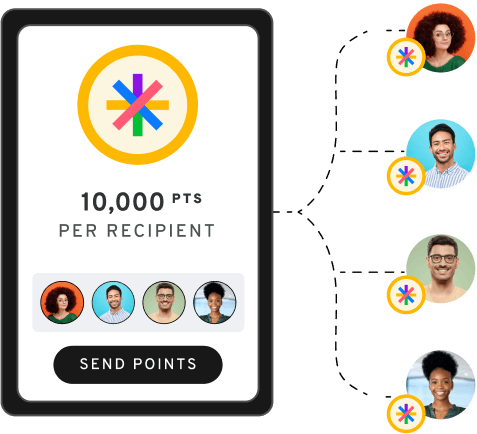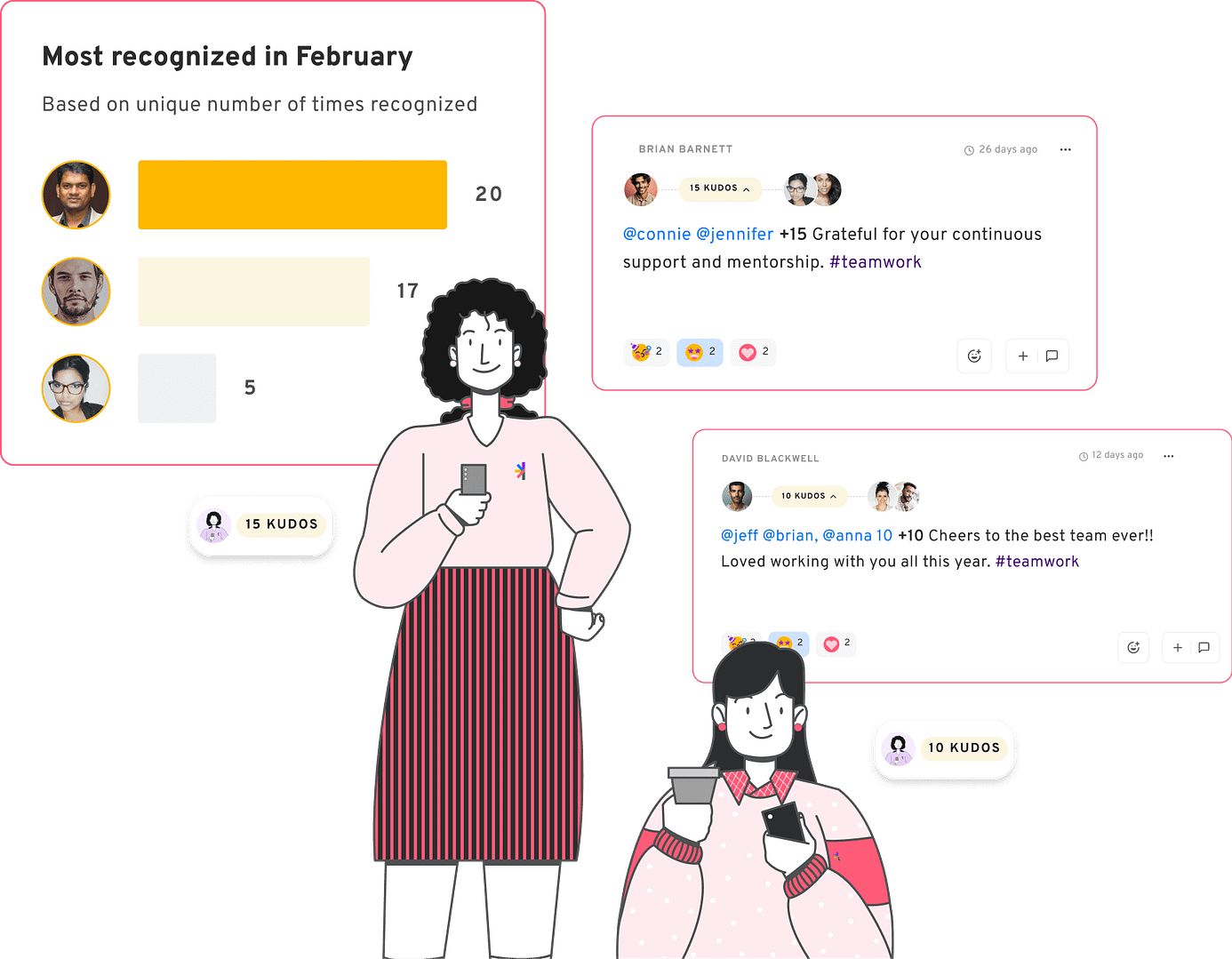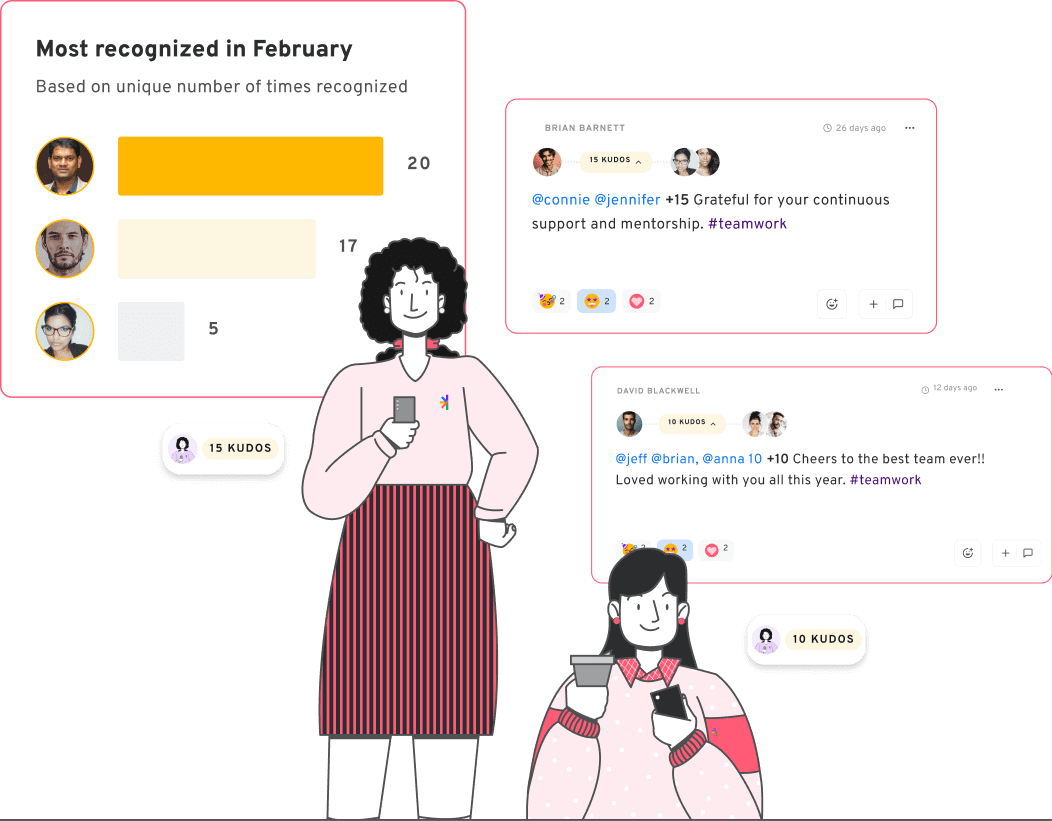Employee recognition
Incorporate Recognition into Employee Onboarding process
How to integrate employee recognition into your onboarding process to enhance the employee experience?
Schedule a call with us to directly integrate the same without any hassle!
The first few weeks at a new employer set the tone for an employee’s adventure.
While most companies focus on training and paperwork during onboarding, forward-thinking organizations are discovering the powerful impact of integrating recognition ideas from day one.
Early appreciation would not simply make a new employee feel welcome—it essentially shapes their perception of corporation culture, accelerates integration, and establishes a basis for long-term engagement.
By weaving employee appreciation into your onboarding revel, you rework a traditionally overwhelming system into a declaring introduction to your values.
This technique can pay dividends through stronger crew connections, heightened motivation, and extensively reduced early turnover—developing a virtuous cycle that advantages individual employees and the organization.
How to Add Recognition into Your Onboarding Process
1. Induction Training: An Integral Part Of Onboarding
Highlighting how employee contributions drive organizational success can transform standard induction sessions into recognition experiences.
Human resources teams should incorporate real examples of recognized work throughout training materials.
This early exposure to the power of recognition establishes appreciation as a core value from day one, creating a foundation for effective onboarding that significantly reduces early employee turnover.

2. Assign Points to Redeem from Recognition Program
Jump-start engagement by allocating recognition currency to new hires immediately.
These employee rewards create an interactive introduction to your recognition platform while giving newcomers agency in selecting meaningful items.
Integrating recognition into the onboarding process through this tangible experience helps employees understand how achievement translates to appreciation, setting positive expectations for this crucial stage of the employee journey.
Stadium enable this feature automatically and you can start sending points from day 1 with customize message.
3. Introduce Them to the Team So They Feel Included
Facilitate structured team introductions incorporating social recognition elements where existing staff share appreciative observations about the new colleague’s background or initial contributions. This deliberate approach transforms standard meet-and-greets into affirming experiences that immediately improve the employee experience by creating authentic connections and demonstrating that every team member’s unique qualities are noticed and valued.
4. One-on-One Discussion: Past Experience Shapes Future Expectations
Schedule conversations specifically exploring how new hires previously experienced recognition and what forms of appreciation resonate most deeply with them.
This personalized approach allows for tailoring future recognition efforts while demonstrating genuine interest in their preferences.
Human resources professionals using these insights can significantly improve employee engagement by ensuring recognition aligns with individual values.

5. New Hire Welcome Kit
Elevate onboarding swag beyond branded merchandise by creating thoughtfully curated welcome packages that reflect an understanding of the individual’s preferences, role challenges, and personal interests.
These customized kits transform standard company merchandise into meaningful symbols of recognition that demonstrate investment in long-term success, making a powerful first impression that helps prevent early employee turnover.
With Stadium, you can create a new hire kit with custom packaging, branded box stickers, and personalized notecards to reflect your company’s identity. Add a warm touch with a video message and deliver an unforgettable unboxing experience for every new team members.
6. Assign Onboarding Buddies or Mentors
Pair new employees with experienced team members explicitly trained in integrating recognition into the onboarding process.
These mentors should regularly acknowledge specific progress and contributions while modeling how rewards and recognition function in your culture.
This relationship creates a safe space for questions while ensuring consistent positive reinforcement during the critical adaptation period.
7. Take Them to “Welcome Lunch”
Recognition should reinforce behaviors that reflect a company’s core values. Without this alignment, recognition serves no strategic purpose and loses its impact.
ByStadium enables organizations to align recognition with specific values, ensuring that each recognition moment reinforces desired behaviors and company culture.
8. Invite Them to Upcoming Company Events
Extend personal invitations to organization-wide gatherings, highlighting how employee recognition and rewards are typically featured at these functions.
This advance notice provides context about recognition’s role in company culture while creating anticipation for meaningful involvement.
You establish belonging as a foundational element of effective onboarding by positioning new hires as valued participants rather than observers.
How Employee Recognition Shapes the Employee Journey
The relationship between employees’ recognition and extensive employee travel represents one of the lowest valid dynamics in organizational psychology.
Recognition does not act as a separate event but rather a constant thread woven with an employee of a company. From early onboard experience to growth milestones and final leadership transition, thoughtful recognition acts both as an anchor and catalyst at each stage of professional development.
When recognition is strategically combined with employee travels, it becomes a powerful narrative with an occasional gesture.
Each acknowledgment is not just a moment of praise but a meaningful chapter in the developed history of the organization’s employees. This integrated approach fundamentally changes how team members see their place in the company’s culture and dramatically shapes their long-term commitment path.
Employee Recognition and the Employee Journey
Employee travel and recognition systems act as interactive elements in the workplace experience. Recognition not only punctures the employee – it shapes active direction and speed. This compound is shown through many main mechanisms:
- Sequential reinforcement: Recognition at important transition points strengthens the employee’s developing identity in the organization.
When gratitude aligns with the most important milestones on the journey, it makes a powerful psychological anchor.
Completing the early training for complex responsibilities creates a powerful psychological anchor that strengthens the engagement.
This sequential reinforcement creates a cumulative feeling of verification that becomes difficult to repeat elsewhere. - Relevant relevance: Effective recognition develops along employee travels -the remaining is relevant to each career scene.
Recognition that inspires a new price on board (perhaps public reception or quality of quality wags) varies from being repeated with an experienced team member (e.g., Pre-Project Management Opportunity).
This relevant consciousness ensures that recognition remains meaningful rather than the formula throughout the employee’s life cycle. - Descriptive integration: Recognition events contribute to an employee’s internal story about their place in the organization. When strategically employed and included in the journey, these moments create a steady story of development and related rather than offline incident events.
This narrative integration helps employees understand their professional development and imagine their future in the company’s culture.
Consider AI role in employee Journey: How AI Can Transform HR and Appreciation
Importance Throughout the Employee Journey
Foundation for Engagement
Employees who are accredited in the preliminary stages establish the baseline for engagement.
When the boarding is woven into the experience, praise immediately creates a positive union that provides a basic form of how the employee feels about his role and organization.
This early foundation makes it later involved in the engagement initiative, as employees have already developed receptivity to the company’s values and reaction systems

Productivity Accelerator
Good recognition under employee travels is a powerful productivity catalyst.
Research continuously indicates that employees who receive regular, meaningful recognition reduce discretionary efforts and absence and show high-quality production.
This productivity dates from better morality and a clear understanding of valuable behavior, creating a virtuous cycle of performance and recognition.

Retention Mechanism
Equal strategic recognition with employee travels improves employees’ storage at dramatically important roadside points.
Carrier development routes experience recognition in 31% less voluntary sales, which only depend on promotion for compensation and storage.
This effect comes from deep organizational compounds that emerge when employees look and feel valuable during their professional progress.

Culture Reinforcement
Employed continuous travel to confirm the desired aspects of culture.
Each recognition acts as a vibrant performance of organizational values in action, creating stability between the principles and daily experiences mentioned.
This adjustment is particularly strong when colleagues become prominent to the colleague, as it distributes cultural reinforcement at all organizational levels instead of limiting it in communication from the top down.

Leadership Development
Accreditation that develops together with employee travels naturally facilitates leadership development.
As team members continue to recognize it and give it to others, they develop important leadership skills around observation, reaction, and inspiration.
This participation in the recognition system converts effective staff into sympathetic leaders who understand how to care for talent and build teams.

Mapping the Employee Journey
Employee travel mapping represents a strategic initiative beyond the traditional HR scheme.
This deliberately visualization process captures the entire employee’s experience with the organization—from his first conversation as a candidate through the final transition outside the company.
Unlike simple procedure documentation, travel mapping requires each stage to be viewed through emotional and experienced lenses from the team members, which postpones both the moments of friction and meaningful connection options.
Organizations that excel at journey mapping gain unprecedented insight into the lived reality of their workplace culture. This perspective shift enables targeted improvements that enhance individual satisfaction and business outcomes.
By understanding the complete narrative arc of the employee experience, companies can strategically position recognition initiatives precisely where they’ll create maximum impact.
The Process of Mapping the Employee Journey
- Identify Key Stages and Transitions: Define the predominant phases of your employer’s ordinary worker lifecycle. While these normally consist of recruitment, onboarding, development, development, and separation, your organization may have unique intermediate stages worth analyzing.
Pay special attention to transition factors between levels, as those regularly represent the best threat for disengagement and the finest possibility for meaningful recognition. - Gather Multi-Source Feedback: Collect insights from personnel at diverse tenure levels through surveys, awareness groups, and one-on-one interviews. Combine these qualitative statistics with quantitative metrics like engagement rankings, productiveness benchmarks, and retention information.
This complete method is a famous style that would continue to be invisible while examining single records assets in isolation, supplying an extra complete picture of the actual adventure in preference to the meant one. - Document Emotional Touchpoints: For every journey level, discover the primary emotional reviews personnel typically encounter. Map these emotions alongside the procedural factors to create a more nuanced understanding of the journey.
This emotional mapping regularly shows unexpected disconnects between organization intentions and employee perceptions—together with onboarding approaches intended to be useful that truly create overwhelm or development opportunities perceived as politically decided regardless of objective standards. - Create Visual Representations: Develop visible journey maps that communicate each procedural waft and emotional landscape of the worker’s experience. These visualizations might take the form of timeline infographics, enjoyment curves, or even narrative storyboards.
The simplest maps encompass annotations identifying modern popularity touchpoints and highlighting gaps where additional acknowledgment could address bad emotional stories. - Involve Cross-Functional Teams: Engage organizational stakeholders in developing and deciphering adventure maps. HR teams provide procedural knowledge, managers offer frontline observations, and executives contribute to strategic context.
This collaborative approach improves the accuracy of your mapping and builds broader organizational buy-in for the popular projects that will, in the long run, emerge from the procedure.
Motives for Mapping the Employee Journey
- Experience Alignment: Journey mapping reveals disconnects between your intended employee experience and the actual lived reality. This insight allows you to align recognition initiatives with genuine employee needs rather than assumed preferences.
When appreciation efforts address actual pain points in the employee journey, they generate substantially greater impact than generic programs developed without journey context. - Resource Optimization: Strategic journey mapping prevents the common pitfall of distributing recognition resources evenly but ineffectively across all stages.
By identifying the emotional low points and high-impact transitions in your specific organizational journey, you can concentrate recognition efforts where they generate maximum return. This targeted approach often delivers better results with fewer resources than broadly distributed programs. - Retention Risk Mitigation: The journey mapping process frequently uncovers previously unrecognized points of vulnerability where employees become susceptible to outside opportunities. Identifying these critical junctures—often around the one-year mark, after project completions, or following organizational changes—enables preemptive recognition strategies that strengthen commitment before disengagement takes root.
- Cultural Differentiation: A thoroughly mapped employee journey highlights the unique aspects of your organizational experience that distinguish it from competitors.
These distinctive elements often represent your most powerful tools for both attraction and retention. Journey-aligned recognition can amplify these cultural differentiators, transforming generic workplace practices into memorable experiences that employees are reluctant to leave behind. - Measurable Impact Framework: Well-executed journey mapping creates a baseline against which to measure the impact of recognition initiatives.
By documenting the current emotional landscape at each journey stage, you establish clear benchmarks for improvement.
This framework enables precise measurement of how recognition interventions affect specific journey pain points, providing compelling data for continued investment in targeted appreciation strategies.
Need Help in incorporating Employee Recognition Program?
Implementing a structured employee recognition program isn’t just a feel-good move—it’s a smart business strategy. When appreciation becomes part of everyday work culture, it boosts morale, engagement, and retention.
Recognition doesn’t have to be elaborate or costly; what truly matters is being sincere, specific, and consistent. When employees know their extra efforts are noticed, they’re more likely to stay motivated and committed.
Even a simple “thank you” can go a long way in creating a workplace where people feel valued.
Start small if needed, but commit. A well-executed recognition program can transform your culture and significantly impact your team’s performance—and your bottom line will reflect that change.
- Peer-to-peer, senior-to-junior, and vice versa
- Assign monetary value to kudos or keep them free
- Integrate with Teams, Slack, or use our platform
- 1M+ gifts from top brands + customizable swag
- Enable kudos to flow freely across your org chart


Are you ready
to take recognition to a whole new level?


